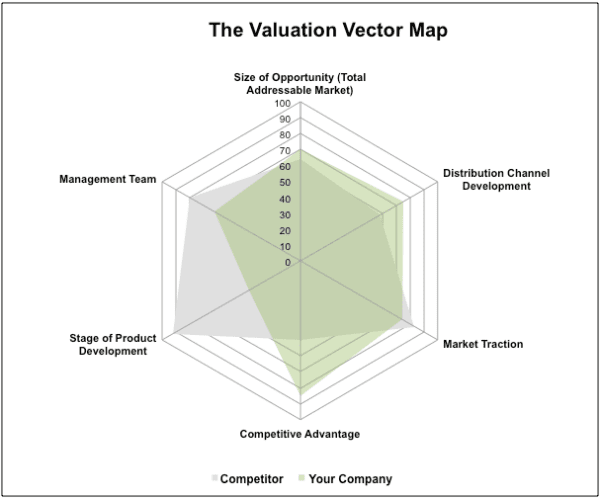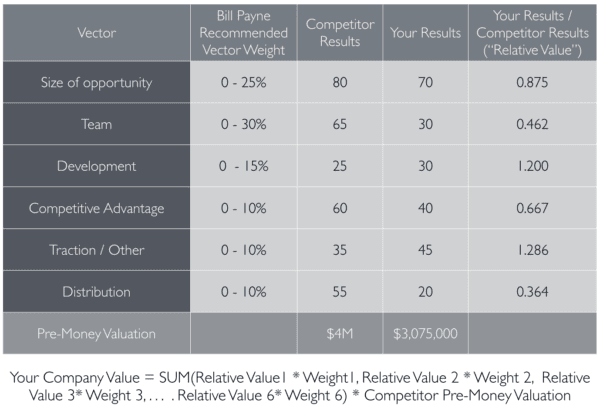Valuation Part I: Peeling the Onion, or How Top Investors Value the Startups They Invest In
Update 2017: To help you understand how your startup will look to investors according to this methodology, we’ve created a fundraising feedback tool that will give you investor-level insight into your startup’s performance. In just about 15 minutes, it will tell you how much money your startup is likely to raise, where you can find that capital, and what to improve about your venture for a better outcome. It’s free!
Early-stage technology company valuations are generally a crap-shoot. Bill Payne wrote a great post about this in October 2011. This post builds on top of his work, and attempts to shed additional light on the valuation process.
New founders may think that startup valuations work like this:
- I figure out what the value of my existing company is
- I figure out how much money I need
- I give the % away equal to: money needed/(valuation + money needed)
In reality, valuation is a process of reducing layers of risk. Each layer is a different kind of risk, like the layers of an onion, and investors are trying to peel off the layers to evaluate the opportunity (analogy courtesy of Marc Andreesen). So, it looks more like this:
- Founder convinces investors that they are investor-ready (“peels the onion”)
- Founder convinces investors they need $X (where X typically equals $500K – $2M for the first priced round)
- Investors ask for 15% – 25% post-money (and get more depending on how well they can negotiate)
- Valuation ends up being calculated (e.g. $1.5M investment/20% stake = $7.5M post-money)
As Marc mentioned in a great how-to-start-a-startup video, investors think about a company’s valuation in terms of risk and rewards. Effectively, they think about value as the inverse of risk. The more layers of risk your company has, the lower valuation you get. The more layers of the onion that have been peeled away, the higher your company valuation.
What the onion model implies is that if you have a weak team and the “economic trends” don’t make sense, but you have high market traction (insert Instagram, Snapchat, Facebook), then your valuation won’t be affected by your team or business model. Your valuation can remain high. Alternatively, if the market opportunities are excellent and you have the best team, but you just can’t get a product to market, then your valuation will remain low.
To assess your own layers of risk, look at the six main categories, or vectors, that investors look at when valuing a company. As depicted above, these are:
- Opportunity Size (Total Addressable Market, direction of market)
- Team (composition, execution experience, subject matter expertise, professional network)
- Development (sweat equity, skin-in-game, milestones completed)
- Competitive Advantage (approach vs. pricing vs. technology vs. network-effect)
- Traction (eyeballs, customers, revenue, earnings)
- Distribution (repeatable processes, recurring earnings)
You can get a better sense of where your company is positioned by first placing your closest (funded) competitor on each vector. An example would look like this:

The scale goes from 0 to 100 where 0=Weakest position and 100=Strongest. Assign yourself a position relative to your competitor, as shown in the above vectors. The columns should be divided into Your Company results and Competitor results, similar to the table below.

Once you have established your scale values, divide them to get your Relative Values. Multiply each of those by Bill Payne’s corresponding Vector Weights, add them together and multiply the sum by your selected competitor’s pre-money valuation. The Vector Weights are relative to your business and can be independently adjusted but should always add up to 100%. If you set a value below its maximum you can add more value to another vector (i.e., if Traction isn’t important to you and Team is, set Traction to 0, and add 10% to Team).
As a founder, focus on showing that you have peeled away the risks and that you have a plan for the money. It’s much easier to raise money with a peeled onion than with a fancy financial model attempting to prove your value.


Gust Launch can set your startup right so its investment ready.
This article is intended for informational purposes only, and doesn't constitute tax, accounting, or legal advice. Everyone's situation is different! For advice in light of your unique circumstances, consult a tax advisor, accountant, or lawyer.


